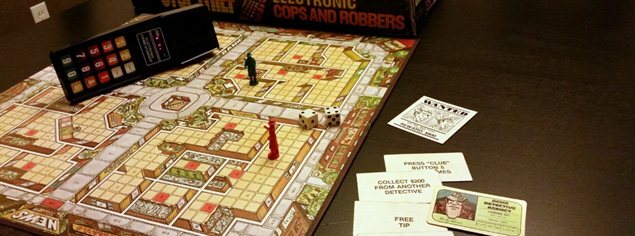
Time Machine posts are a look back at games that are 30+ years old. We’ll share some of the history behind the game and why we believe it should have a place on your family game shelf.
Growing up, our family game collection wasn’t extensive, but one game always stuck out in my mind. The front of the game box lifted up to show off this large handheld mobile device that filled me with amazement. The family that was pictured on this box was a portrait of family gaming in the late 70’s and early 80’s. The game Stop Thief was ahead of its time and holds some of my favorite memories of playing board games as a kid.
Innovation in Tabletop Gaming
Stop Thief was published by Parker Brothers in 1979 and was the creation of Robert Doyle. After earning his doctorate in astrophysics from Harvard in 1968, Doyle began working with NASA in the early 70’s. He had a vision that sound and computer technology would change the toy and game industry forever.
Parker Brothers believed in Robert’s vision and in 1978 they released Merlin, an handheld electronic device that looks like a cell phone. The device played six different games like Blackjack, Tic Tac Toe and allowed players to program a tune for playback. Merlin was ahead of its time and was the beginning of a huge change to the toy and games industry.
Doyle went on to develop the Mattel Electronic Football, Electronic Battleship, a submarine pursuit game and my beloved Stop Thief. He was also the man behind MacPublisher, the first word processor for the Macintosh and is responsible for the digital audio content that we know now as “podcasts”.

That Sweet Sweet Police Scanner
At the center of Stop Thief was this piece of technology that was amazing to any child born before 1985. The “Police Scanner” looked like an over-sized mobile phone and had a multi-colored keypad. The players would use this as a source of information on where the criminal was on the board.
The board contained hundreds of squares that featured subway entrances, four buildings and city streets. Players take on the role of a detective and move around the city by rolling dice starting at the Detective Agency. At the beginning of the game, the Police Scanner would notify everyone of a burglary in progress. This was a very memorable sound and the red display would tell everyone what building it happened in.
The game did an incredible job of making the players feel like they were tracking something important.
Each time a player started their turn, they would hit the CLUE button on the Police Scanner. Another sound would play and the red display would change. There were different sounds for walking across the floor, breaking a window, opening a door, walking the street, getting in the subway and committing another crime.
Are You Keeping Track?
Everything revolved around hearing the sound and trying to figure out how this invisible criminal moved around the board. There were some basic rules that guided the criminals movement and they have to move from numbered space to numbered space.
As I got older, I realized the value of having scrap paper on hand and recording the criminals movements. I loved the game because the person who really paid attention and focused on the clues would always outwit the other players. There was so little luck in this game that people couldn’t just accidentally win.

When you thought you knew where the criminal was, you would grab the Police Scanner on your turn and type in their location number (you had to be on the space or adjacent). Sirens would sound, all the players would listen closely and their were three possible outcomes. The player was flat out wrong, the criminal would get carted off to jail or they would make a daring escape which changed the course of the game.
Catching the criminal meant that you would be awarded money but making an incorrect guess caused you to lose your detective license and pay $200.
True Detective
The game did an incredible job of making the players feel like they were tracking something important. As the detectives, you could play up your persona that was on your “detective license”. Each criminal had a background and some really ridiculous puns on each card.
We have my family’s copy of Stop Thief in our family library. It’s in great condition for a game that was purchased shortly after its release from a Toys R Us in New York (the orange sticker is still on the box).
This game was so important to shaping my love of board games. You felt like a beast when you tracked down the criminal and outwitted your parents. Every time I open the box, that same sense of wonder comes back to me. I’m grateful that an astrophysicist named Robert Doyle reshaped the landscape of tabletop gaming and helped me fall in love with family game nights.
I keep hoping for a remake of this amazing game, but until then, you can pick up copies of Stop Thief on Ebay.




[…] I think about board games and my childhood. One is when my Mom and Dad taught me to play the game Stop Thief. The other was the time my Dad came home with a copy of Kerplunk that he bought when he was away […]
[…] gave players clues as to the location of the hidden criminal that everyone was chasing. This was ahead of its time in 1979 and merged electronics and […]
[…] Chronicles of Crime is a truly innovative game and it does it so well. I’ve been so surprised by how well the app works with the game components and the level of polish on the game is impressive. This game brings me back to my first time experiencing the Crime Scanner as a kid with the game Stop Thief. […]